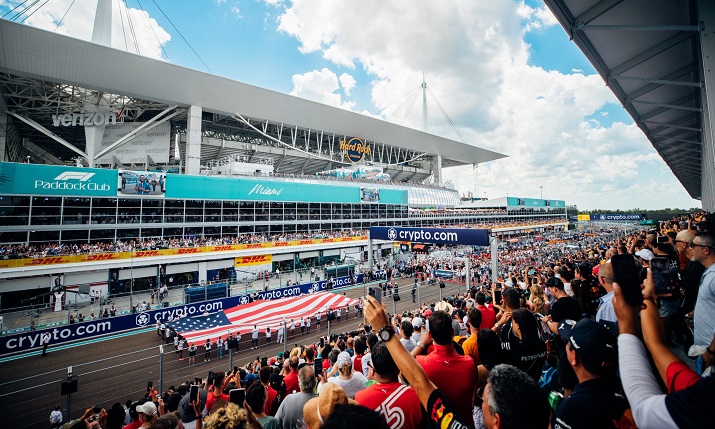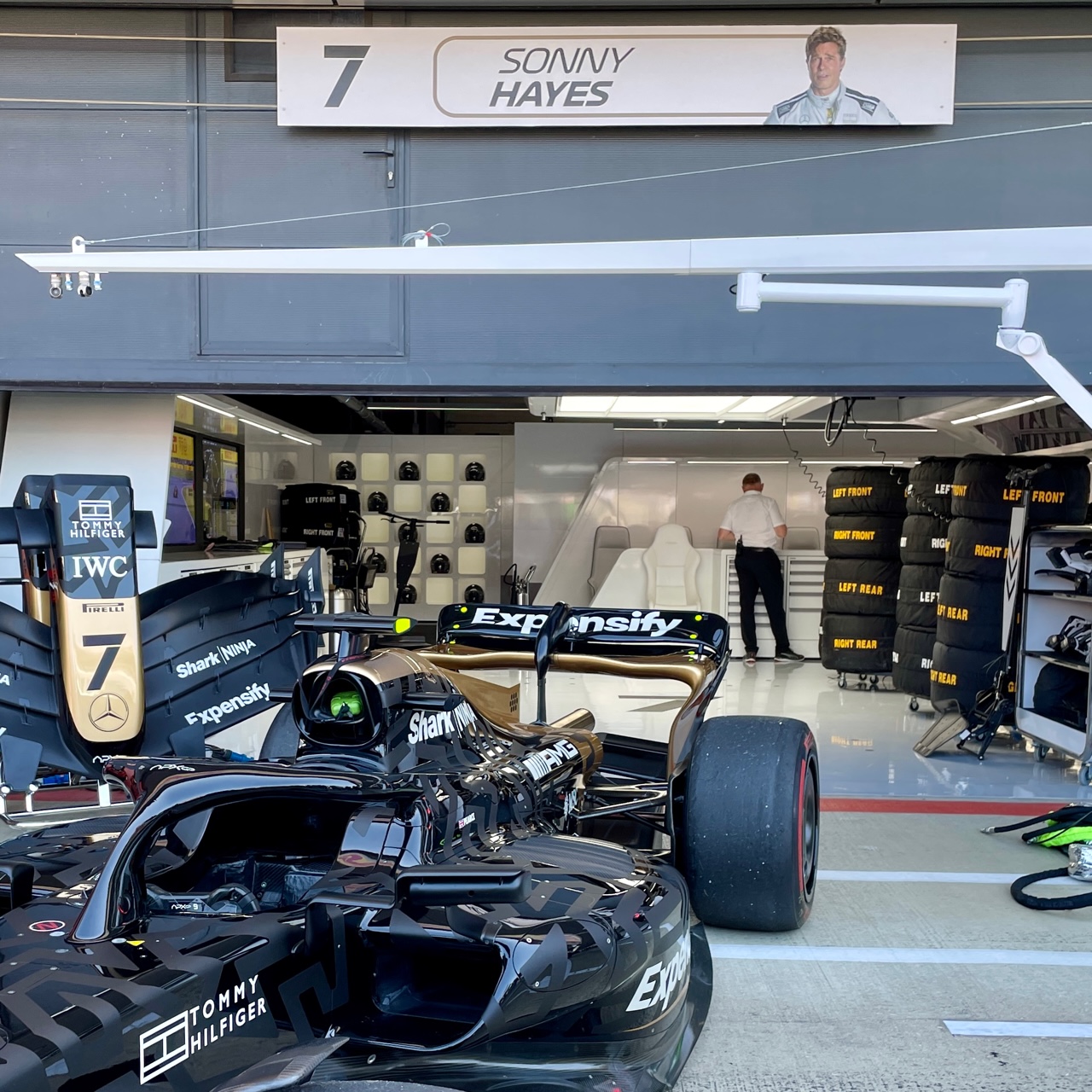F1 2024: Capturing the action with drones, new camera angles and AI

Last year’s F1 Miami Grand Prix: This year’s race could see the rollout of a new rear light camera (Brandon Brieger/F1 Miami GP).
Getting viewers closer to the action is one of the priorities for all sport production teams, and for Formula 1 that means contending with the “really tough” environment of a Formula 1 car.
“We’re always looking and trying to come up with new angles,” explains Formula 1 director of broadcast and media Dean Locke. “Something we’re looking at is a new rear light camera. The very rearmost part of the Formula 1 car is the rear light, and for a while we’ve been trying to get a camera in there because you’ll get the nose of one car and the rear of the other car at their closest.
“We’ve worked closely with Aston Martin to develop that, and we were very confident we’ll roll that out this year, hopefully from Miami onwards. It will be added to the rulebook so it could be used on any car.
“We also did some really nice stuff towards the end of last year with the side chassis camera, which shows the undulations in the track and we’ll do a bit more with that, because we were surprised at how good that looked. One of the shots that stood out was Alonso in Brazil, where the camera helped to show some of the banks around that track.”
Read more F1 2024: IP upgrades and the “almighty challenge” of a record-breaking F1 calendar
The Formula 1 broadcast team is also looking at the amount of vibration that viewers see; without any damping elements a camera is likely to be shaken apart, but as with the helmet camera Locke wants viewers to experience some of the vibration.
He explains: “Being able to see that kind of violence really gives the viewer a bit more admiration for those Formula 1 drivers. So we’re hoping to dial some of that in to be able to give that true reference of what it’s like for the driver in the cockpit.”
Racing drones
Just over a week ago, Dutch Drone Gods shared some footage of a drone following Max Verstappen’s new Red Bull RB20 F1 car during a test lap of Silverstone. Billed as “the world’s first uninterrupted FPV one shot”, the footage subsequently went viral and prompted many to ask whether such shots could be incorporated in the live coverage of Formula 1 races.
“Drones are exceptional for post-produced sports content, but it’s a bit trickier for us,” explains Locke. “Formula 1 is so fast, we’re live, and we are very low latency. Plus, we can have over 400,000 people turn up over a race weekend. So we also need to ensure we have created a safe area for spectators.
“But we are keen to work with drone companies to see what we might be able to achieve. Also, we’re very good at getting things off fast moving vehicles at low latency, in great quality, so what we have found is that we’ve also got quite a bit to share so we’re not just looking for a third-party solution.”
As well as the Dutch Drone Gods Red Bull footage, skiing is a sport that has pioneered the use of first-person view drones as a way of conveying speed.
“My boss definitely likes [FPV skiing shots], because he sends me a text every time he sees them,” jokes Locke. “I do too, but there is a slight advantage with skiing, because of course they’re not quite as fast as Formula 1. And the drone can sit behind the skier which of course you can’t do between cars. But we’re working pretty hard on it, and there’s some circuits that work well, such as Spa and the Netherlands that really look good. We did some testing in Austin, too, and that went pretty well.”
New AI-enhanced replay system
With so much action taking place at the same time on different parts of the track, replays are an essential aspect of the Formula 1 production setup which this year has been overhauled.
“We have so much that relies on how we replay that content, but also how we include those replays, because we don’t get natural breaks,” says Locke.
“So when we looked at a new replay system IP was a big part of what we were looking for, and AI was a big element too because we want to make it easier for our operators to find content whether that’s putting data into the pictures so we can call those back, or whether it’s some of fantastic developments around creating interpolation and making up frames and creating slow motion shots from normal speed cameras – that really blows my mind when I think back to my old school broadcast training. Some of the testing we’ve done so far has been really exceptional.
“Also, the network capabilities have improved dramatically over the years which is important because we’re always operating two sites. We do have high motion replays on site at tracks as well, but it’s also our disaster recovery replay system, so having a really strong bond between those two systems is great and it makes it easier for us to get operators in as well.
Audio enhancements
One of the aspects of the in-person viewing experience that is arguably hardest to replicate for armchair fans is the sound of 20 Formula 1 cars hurtling around a circuit. As Locke explains, it is not just how that sound is captured but also how it’s managed and processed that is important – particularly with many Formula 1 viewers arriving via post-produced shows such as Netflix’s Drive to Survive and the potential for more fans to flock to the sport when Apple’s untitled Formula 1 feature starring Brad Pitt and Damon Idris is released.

Apple feature film: The fictional Team Apex with Brad Pitt as driver ‘Sonny Hayes’ at last year’s Silverstone grand prix.
“Last year, I was particularly proud of was Monaco, and Las Vegas – we did a lot of work on the audio placement around Monaco because we’re so close to the action. And the same with Las Vegas – there was a lot of planning in that, because of the number of tall buildings around the circuit and the echoing, there was quite a lot of work. So I’m very proud of that.
“It’s harder, of course, at the big open circuits to get that audio. We’ve been working very closely with the Formula 1 movie team; they take all our audio strands and take it to the Skywalker Ranch and do some incredible magic in there. So we’re very alert to the fact that’s what people will think Formula 1 sounds like, so we need to push our boundaries to say, ‘Ok, we can’t quite do what they’re doing in a post produced environment, but can we improve it a little?
“I had a meeting with the audio team last week to discuss some concepts and some ideas, particularly the on-car – how can we improve that even a little bit? That’s the challenge.”
Read more F1 2024: Explaining the action with more kid-friendly broadcasts and a boost to team radio

